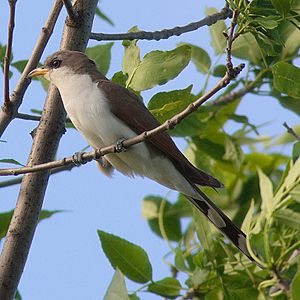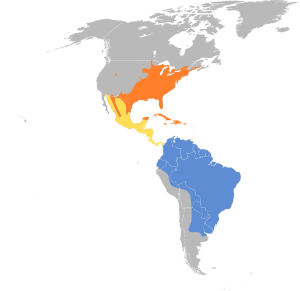Yellow-billed cuckoo facts for kids
Quick facts for kids Yellow-billed cuckoo |
|
|---|---|
 |
|
| Conservation status | |
| Scientific classification | |
| Genus: |
Coccyzus
|
| Species: |
americanus
|
 |
|
| Synonyms | |
|
Cuculus americanus Linnaeus, 1758 |
|
The yellow-billed cuckoo (Coccyzus americanus) is a type of cuckoo bird. People in the southern United States often call it the rain crow or storm crow. This is because it often calls out on hot days, which can sometimes mean rain or thunderstorms are coming.
The name Coccyzus comes from an Ancient Greek word that means "to call like a common cuckoo". The word americana means "from America".
What the Yellow-Billed Cuckoo Looks Like

Adult yellow-billed cuckoos have a long tail. It is brown on top and black and white underneath. Their bill is black and curved, with yellow on the bottom part. Their head and upper body are brown, and their belly is white. They also have a yellow ring around their eyes. When they fly, you can see a cinnamon color on their wings.
Young cuckoos look similar to adults. However, the black on the underside of their tail is gray instead of black.
Measurements:
- Length: 10.2 to 11.8 inches (26 to 30 cm)
- Weight: 1.9 to 2.3 ounces (55 to 65 grams)
- Wingspan: 15.0 to 16.9 inches (38 to 43 cm)
Protecting the Yellow-Billed Cuckoo
Scientists are still discussing if the yellow-billed cuckoos in the western part of North America are different from those in the east. This is important because the number of these birds in the west has dropped a lot over the last 100 years. They have disappeared from places like British Columbia, Washington, and Oregon.
Even though eastern populations have also decreased, it's not as much as in the west. Because of this, the western group of yellow-billed cuckoos was listed as "threatened" in 2014. This means they need special protection to help their numbers grow again. The government has also set aside large areas of land in nine western states as important habitat for these birds.
Where Yellow-Billed Cuckoos Live and Travel
Yellow-billed cuckoos like to live in deciduous forests. These are forests where trees lose their leaves in the fall. They can be found from southern Canada all the way to Mexico and the Caribbean.
When winter comes, these birds migrate south. They fly to Central America and even as far as northern Argentina. Sometimes, a few birds might fly off course and end up in western Europe, but this is very rare.
What Yellow-Billed Cuckoos Eat
These birds look for food in thick bushes and trees. They can also catch insects while flying. Their main diet is insects, especially tent caterpillars and cicadas. They also eat some lizards, eggs from other birds, and berries. Sometimes, many cuckoos will gather in one place if there are a lot of insects, like during an outbreak of gypsy moth caterpillars.
Life Cycle and Reproduction
Yellow-billed cuckoos build their nests in trees or bushes. Their nests are usually about 2 to 12 feet (1 to 4 meters) above the ground. The nest is a simple platform made of small twigs on a flat branch.
The female usually lays 3 or 4 eggs. The parents sit on the eggs for about 14 days or less until they hatch. The baby chicks can climb around very well when they are 7 to 9 days old. Around this same time, their feathers grow quickly, and they are able to fly. The whole process, from when the egg is laid to when the young bird can fly, can take as little as 17 days.
Sometimes, yellow-billed cuckoos lay their eggs in the nests of other birds. They often choose the nests of the black-billed cuckoo, which is a close relative. However, they do not always rely on other birds to raise their young, unlike the common cuckoo found in Europe and Asia.
Images for kids
See also
 In Spanish: Cuclillo piquigualdo para niños
In Spanish: Cuclillo piquigualdo para niños




